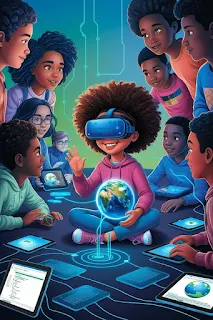Why Teachers Will Always Be Irreplaceable in the Age of AI
Introduction: Education in the AI Era
In a world increasingly shaped by Artificial Intelligence, the question naturally arises—could AI ever replace teachers? After all, AI can deliver lessons, mark exams, and even personalise learning pathways. Yet despite its dazzling capabilities, the role of the human teacher remains not just relevant but absolutely irreplaceable. In 2025 and beyond, teachers will continue to be the heart and soul of education, bringing empathy, creativity, and critical human connection into the learning process.
The Human Touch That Machines Cannot Replicate
While AI excels at processing data and offering tailored content, it fundamentally lacks one critical element: empathy. A human teacher can perceive a student’s anxiety, boredom, excitement, or confusion through subtle body language, facial expressions, and emotional cues. Teachers can then adapt their approach accordingly—something AI, no matter how sophisticated, struggles to replicate genuinely.
Emotional intelligence, compassion, and encouragement are qualities only a real human being can offer, creating a classroom atmosphere that nurtures not just academic success, but emotional growth too.
Inspiring Curiosity and Passion
AI may be able to answer questions, but it cannot ignite a lifelong love of learning in the same way a passionate teacher can. Great educators inspire curiosity, spark imagination, and show students the joy and wonder of discovery. They connect subject matter to real-life experiences, current events, and personal passions, transforming lessons from mere information into meaningful exploration.
It’s this inspiration, this human spark, that lays the foundation for future innovators, leaders, and dreamers.
Role Models and Mentors Beyond the Curriculum
Teachers are not just transmitters of knowledge; they are role models, mentors, and guides. They demonstrate perseverance, resilience, respect, and responsibility through their actions. In doing so, they teach students life lessons that go far beyond any academic curriculum.
A student who struggles with self-confidence or personal challenges often finds support not in algorithms but in the listening ear and genuine advice of a trusted teacher. AI can offer facts, but teachers offer wisdom.
Cultivating Critical Thinking and Debate
AI can provide information, but it is teachers who train students to question, analyse, and debate. In a world overflowing with information—and misinformation—critical thinking is more vital than ever.
Teachers encourage students to:
-
Challenge assumptions
-
Engage in healthy debates
-
Develop well-rounded arguments
-
Reflect on multiple perspectives
These skills, crucial for democratic societies and dynamic economies, cannot be outsourced to machines. Only human educators can nurture truly independent thinkers.
Adaptability in Unpredictable Situations
Education isn’t always a predictable journey. Unexpected classroom situations arise all the time—be it an emotional outburst, a sudden misunderstanding, or a sensitive social issue. While AI can follow programmed protocols, only a human teacher can respond to these moments with sensitivity, creativity, and emotional agility.
In crises, such as a student grieving a loss or a community facing natural disasters, teachers become beacons of support. They adapt lesson plans, offer comfort, and rebuild a sense of normality—demonstrating the irreplaceable value of the human element in education.
Building Community and Collaboration
Schools are more than just places of learning—they are communities where students build friendships, learn social skills, and understand the values of collaboration. Teachers are the linchpins that hold these communities together, fostering respect, empathy, and teamwork.
AI can facilitate communication, but it cannot cultivate the deep, meaningful relationships necessary for a healthy, vibrant learning community. Teachers model and mediate these relationships every single day.
Guiding Ethical Understanding in a Digital Age
As technology advances, ethical questions about privacy, AI bias, digital addiction, and misinformation become increasingly complex. Students need ethical guidance, not just technical instruction.
Teachers help students navigate the moral dimensions of living in a digital world by discussing topics like:
-
The responsible use of technology
-
The ethics of artificial intelligence
-
The societal impact of digital platforms
While AI can present ethical scenarios, it is the teacher who facilitates nuanced discussion, encourages reflection, and nurtures moral development.
Lifelong Learning and Personal Growth
Education is not just about preparing for exams—it’s about preparing for life. Teachers encourage resilience, curiosity, humility, and continuous learning, preparing students to face the future with open minds and adaptable skills.
In 2025, with industries evolving rapidly and knowledge expanding at an unprecedented pace, the ability to learn how to learn is more critical than any one set of facts or figures. And it is human teachers who guide students along this never-ending journey of growth.
Conclusion: Teachers Are Here to Stay
While AI is transforming education in countless positive ways—enhancing access, personalisation, and efficiency—it can never replace the heart of teaching. Teachers are mentors, counsellors, motivators, and friends. They breathe life into lessons and character into students.
In 2025 and beyond, the future of education lies not in choosing between AI and teachers, but in harnessing technology to empower teachers to be even more effective, creative, and compassionate.
Teachers will always be irreplaceable—not despite technology, but because the human connection they provide is more valuable than ever in a digital world.










